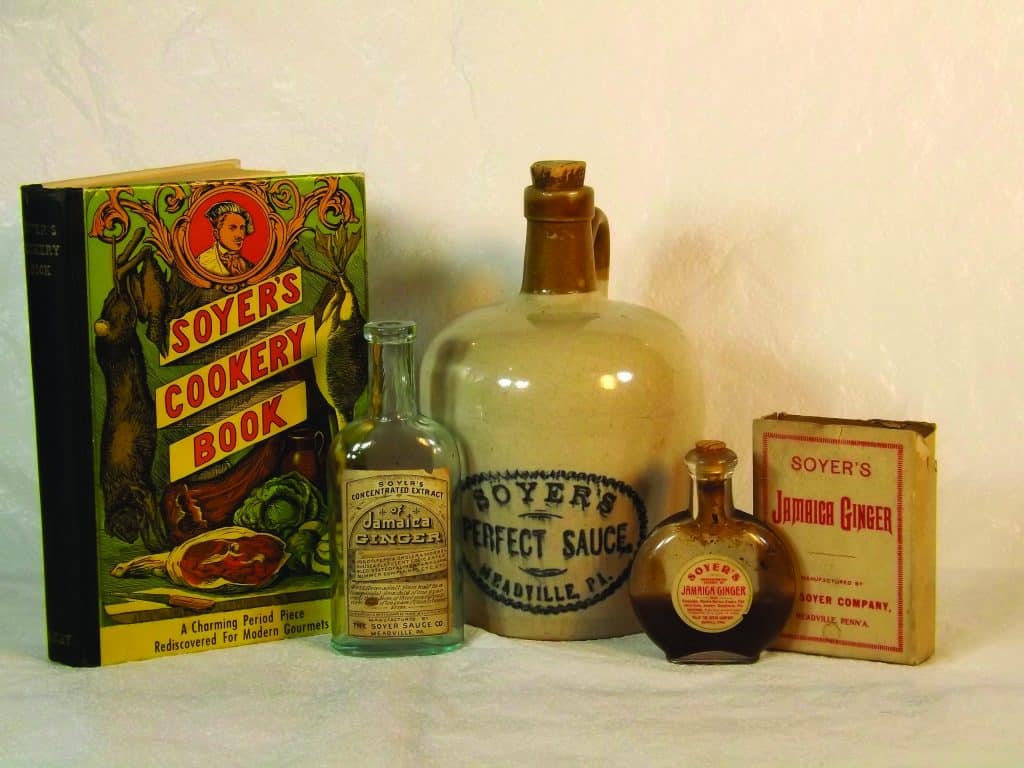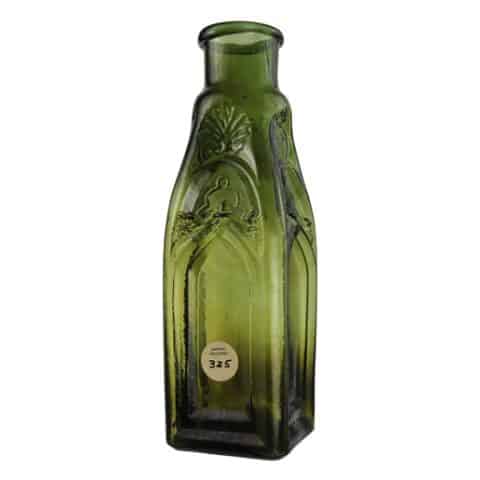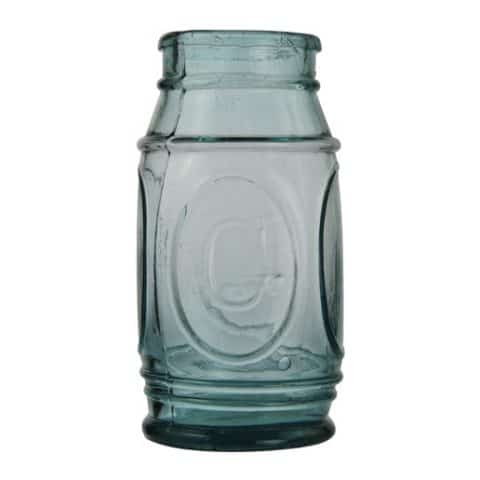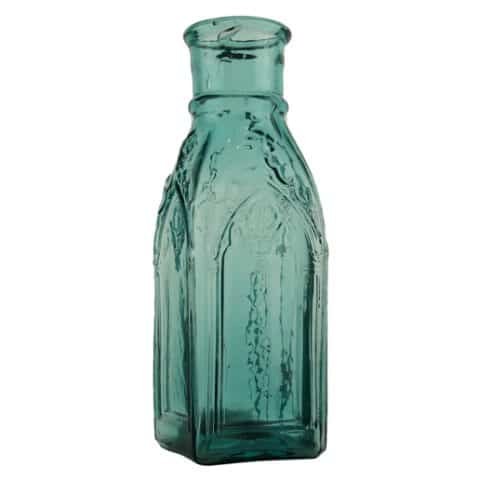Soyer’s Sauce
Soyer’s Perfect Sauce
Alexis Soyer, France
Rev. Dr. J. C. Carnachan, Meadville, Pennsylvania
Amber Fancy Bottle
Provenance: Lou Pellegrini Collection

Our amber Soyer’s Sauce bottle has a very lyrical and sensual shape and reminds us of the figural Violin bottles that some collect or even a Cassin’s Grape Brandy Bitters. The bottle is embossed ‘SOYERS SAUCE’ on the front in an arch between two engaging embossed scrolls. There is a pedestal base, improved pontil, a medium neck, and a rounded applied doughnut collar. There is a 567 Charles Gardner personal inventory sticker on the neck and remnants of another sticker on the base. The reverse side of the bottle has no embossed copy but does have the embossed scrolls. The bottle is about 6-7/8″ tall, extremely rare, and has been reported in clear glass too.
The story of Soyer’s Sauce is one of a very unlikely marriage of a European chef, a Presbyterian minister, and a corset company. This story is probably unlike thousands of others lost to time, waiting to be rediscovered.

Alexis Benoit Soyer was born in France in 1810. By 1826, Alexis had finished a five-year restaurant apprenticeship. By the first part of 1830, he was named the head chef at D’Ouix. It was here that Alexis barely escaped death while cooking a banquet for Prince de Polignac. An angry mob burst into his kitchen and he escaped death by breaking into a “spirited rendition of La Marseillaise.” The mob loved him and carried him on their shoulders to the street.
All the disorder in France at that time in history convinced Alexis in late 1830 to immigrate to England at the age of 20. After a series of jobs cooking for British Dukes and Marques, he was named the chef of the prestigious London Reform Club in 1837. Alexis went on to write cookbooks for the ordinary man. By 1846, he was deeply concerned about the Irish potato famine. He requested a leave of absence to organize soup kitchens in Ireland to feed the poor. His soup kitchens were designed to feed up to 5,000 per day but often exceeded 8,000 a day. His book, “Charitable Cookery” was written during his time in Ireland to raise money for charities that serve the poor.

Returning from Ireland in 1849, Soyer turned his attention to improving kitchen appliances and invented various stoves including a camping stove called the “Soyer Field Stove” which enabled cooking no matter what the weather was, and one he called the “Magic Stove.” He volunteered and gained permission to travel to the Crimea where the British were fighting the Russian Empire to organize and store rations for the soldiers. He also appointed chefs responsible for cooking for the entire regiment. Working with Florence Nightingale, Soyer improved the diets of the patients in the hospitals. It was in Crimea that he contracted a fever that led to his death.

The Rev. Dr. J. C. Carnachan was born in Scotland in 1829. He became an ordained Presbyterian minister. It was during his travels that he visited the London Reform Club, ordered a meal prepared by the kitchen with Chef Alexis Soyer. He was so impressed with the sauce that he met Soyer and obtained the recipe. He returned home and prepared batches of the sauce to the delight of all. It was later that he immigrated to the United States and moved to Meadville, Pennsylvania to preach at a local Presbyterian Church.
It is unclear why, but probably with the urging of family and friends, Dr. Carnachan gained the American rights for the Soyer Sauce from Crosse & Blackwell who were the Sole Agents, and in 1867 formed the “Soyer Sauce Company” which he located in downtown Meadville. Soyer’s Perfect Sauce was advertised to consist of very expensive vegetables, spices, and aromatics. Some of the ingredients were said to be imported from China, India, and Europe. Many believe that the sauce was similar to today’s Worchester Sauce.

As the company expanded in the late 1800s, they were able to add other product lines and they gradually changed to using “The Soyer Company” on their packaging and labels. Carnachan remained active with the company up to his death in 1903.
In 1907, the Spirella Corset Company purchased The Soyer Sauce Company and changed the name to The Soyer Company of America. The Spirelli Corset Company had found fame and fortune with a great marketing plan and held a patent for a flexible stay. The Spirella Corset Company was founded in 1904 and was located in downtown Meadville. They found success by advertising their corsets as “Factory to Consumer.” They would sell their corsets directly to the public using corsetieres. They began small in a small loft with six sewing machines, six seamstresses, and a superintendent of operations.
The invention of the flexible stay to replace the whalebone support in the corset revolutionized the design and the company grew at an amazing pace. Women actually risked severe injury or death when one of the whalebone stays would break and puncture the abdomen. The inventor, Pa Beeman, was challenged by his wife to invent the flexible stay after an embarrassing and painful failure of one of the whale bones at a party. By 1912, the company had gone worldwide.
It was their “Factory to Consumer” method that they brought to the marketing of Soyer products. They expanded their product line to include food products and toilet articles. Their plan was to market all their products door to door thus eliminating three to five middlemen. The model was perfect for the Spirella Corset Co. but failed the Soyer Company of America. By 1912, the Soyer Company of America was gone from the local directory. According to the 1938 Meadville… It’s Past and Present, the company failed because of “The high rate of turnover in salesmen.” Our best guess is that the huge success of The Spirella Corset Company made The Soyer Company of America so insignificant that very little effort was made to run the company.
Primary Image: Soyer’s Perfect Sauce bottle imaged by the FOHBC Virtual Museum west coast studio by Gina Pellegrini.
Support Primary Research: Reference to Soyer’s Perfect Sauce by Alan DeMaison, FOHBC Bottles and Extras, May-June 2018
Support: Reference to Ketchup Pickles Sauces – 19th Century Food in Glass by Betty Zumwalt
Join the FOHBC: The Virtual Museum is a project of the Federation of Historical Bottle Collectors (FOHBC). To become a member.











































